The Cranky Editor's
10 FREE Writing Tips
The following 10 FREE Editorial & Writing Tips are adapted and paraphrased from The Cranky Editor's Book of Intolerable Fox Paws (Oops! Faux Pas!): Helpful Writing & Style Tips So You Won't Look Stoopid, by Reginald W. Bacon. (Yes, you can BUY the book here.) You'll find that the 10 FREE Tips are really 10 categories of tips --- there is helpful information crammed into each category. Just like the book, however, these tips are more of a "crisis intervention" for the non-professional writer than a comprehensive guide to rhapsodically elegant prose. Understand that any collection of just 10 tips will only scratch the surface of the writer's craft. Nevertheless, by studying the 10 FREE Tips, using them, and internalizing them, you'll see aspects of your finished product improve straightaway. Go forth with gusto! With your new language skills, you'll help avert the decline of civilization!

The 10 FREE
"Categories" of Writing Tips:
The preparation:
(1) Get a stylebook & dictionary. Use them!
(2) Know your goals, purpose, & audience.
(3) Get organized before you begin writing.
The writing: Let everything flow!
The polishing of the jewel:
(4) Buck up the verbiage.
(5) Cut flab. Drop jargon. Don't be a bore.
(6) Pay attention to usage: Look stuff up!
(7) Check your spelling. Spell-check is dumb.
(8) Make sure you make sense.
(9) Pay attention to punctuation.
(10) Editing, proofreading, & typographic style.
Below is expanded information on each category, shared in generous spirit, with the hope that it improves the effectiveness and communicative function of your do-it-yourself projects. And of course if you find the information helpful, and if you ever start to feel like a deadbeat, yes, you can BUY the book here!
The preparation:
(1) Get a stylebook & dictionary. Then use them!
Get a stylebook (AP, Chicago Manual, N.Y. Times, MLA) and a dictionary (Merriam-Webster or Webster's New World), in hard-copy, keep them within arm's reach, and use them until they're tattered. Then get new ones and do the same thing. Go ahead and use them for bedside reading, too. Your writing will benefit. (What's a "stylebook"? See the sidebar at the right.)
(2) Know your goals, purpose, & audience.
Have an idea: Know your goals, purpose, and audience before you start writing. Before turning on your computer and barging into a writing project, have a clear idea of exactly what you want to accomplish and who you want to reach. Get out your pencil-and-paper and craft your outline from introduction to concluding summary. I don't recall who said it (maybe it was me?), but "Clear thinking begets clear writing." Take the time away from the computer to focus and think. In your pencil jottings, formulate a logical argument for your prospective readers that will lead them to agreement with, excitement for, or understanding of, your product, service, program, or proposal.
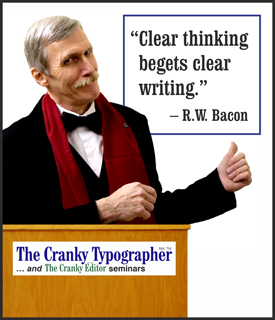
Once you have crafted an outline and know the order of your ideas, it's time to consider your reading audience, as your audience determines the tone, personality, and even the word-choice of your writing. This should be obvious: People are not all the same. That is, not everyone is a poet and Ph.D., and not everyone is a grunter and pointer. Remember that in much business writing, you are not writing for yourself, but for your reading audience. When you're writing for a particular audience, especially an audience that may be outside of your social, cultural, economic, or generational circle, there is homework and some analysis to be done beforehand. It can be difficult without broad life experience, but a good general-purpose writer must learn to "get outside of one's self" and see the world from other points of view.
With an outline structure complete and the reading audience identified, you're almost ready to turn on the computer. But not quite.
(3) Get organized before you begin writing.
Get organized: Consider the physical format of your piece before you begin writing. In any print or Web project, it is wise to think ahead visually about the physical format of the end-product before you begin writing. Will the writing-to-come eventually be used in a three-panel brochure? Annual report? Sales letter? Grant proposal? Newsletter? Magazine? Web site? HTML page or downloadable PDF? The physical format influences the length of the written piece, of course, but it also influences the composition of headlines, the layout of body text, and the integration of photos, illustrations, and other graphic elements.
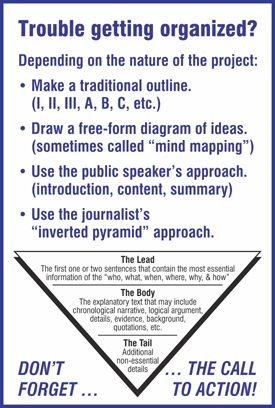
At the organization stage, gather the raw materials you need to get the job done: the facts & information, the references that support assertions, rough drafts or snippets of copy, photos, illustrations, and any logo or identity materials.
After assessing the physical format, raw materials, and reviewing the outline, there are old reliable organizational aids that can help the hesitant writer jump in to the actual writing. They are "the 5W's" of journalistic writing, the "inverted pyramid" approach to organization, and the "public speaking" approach to organization. All are detailed in The Cranky Editor's Book of Intolerable Fox Paws. (Yes, you can BUY the book here.) The approach adopted for a particular project will help you keep your paragraphs to manageable size. Finally, if your piece is persuasive writing that aims to make a sale or advance an idea, including a strong "call to action" is a vital component of your organizational plan.
The writing:
By now your ideas have percolated and are ready to blow the lid off your outline. It's time to write! Now you can turn on the computer and let everything flow. Aaah. To be done with the writing is a relief, so you can take a breather before you bign to polish your jewel. The next eight tips deal with combing through your writing and polishing it into a sparkling finished product.
The polishing of the jewel:
(4) Buck up the verbiage.
Buck up the verbiage. Drop wimpy words. Recast clumsy sentences. Whenever possible, use strong descriptive verbs instead of weak imprecise ones. Instead of "Happy Uncle Fritz walked, in his decidedly unsteady shuffling gait, to his favorite corner store," try "Happy Uncle Fritz staggered and wobbled all the way to his favorite corner store." Use active voice, with few exceptions. Let the subject of the sentence carry out the action of the verb. It's clear that "The bear shambled through the woods." Bears do everything in the woods. But some writers habitually bog down in the passive voice and write "The woods were shambled through by the bear." the passive voice slows the action to a crawl. Make sure that the verb in a sentence agrees with the subject --- singular subject to singular verb, and plural subject to plural verb. Streamline sentence structure. Instead of "Calvin spoke with a resolute insistence that his views be considered," try "Calvin insisted that his views be considered."
(5) Cut flab. Drop the jargon. Don't be a bore.
Cut the flab, drop the jargon, don't be a bore, and jettison the dull business-speak. Get rid of the flabby phrasing, misbehaving modifiers, pretentious words, boring words, jargon, cliches, and hype --- anything that complicates instead of clarifies.
Flabby: "Mr. Jones committed an unwise fistic assault on his immediate superior, and was summarily terminated from his position."
Fit: "Jones punched his boss in the nose, and was fired."
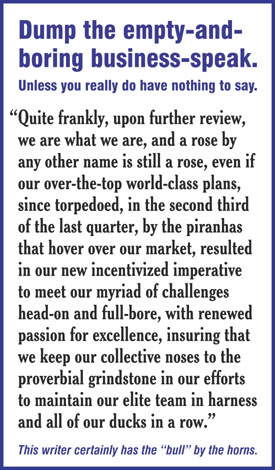
Flabby: "The top tier private-sector leadership will raise the bar and leverage the shifting paradigm, reaching out with a state-of-the-art solution that all can buy into if they are willing to think outside the box. This will empower the second tier managers, usually hamstrung by too much on their plate, and with the third tier managers in the trenches on board, they will be better equipped to avert crisis situations, run more ideas up the flagpole, and truly take performance to the next level. In the final analysis, it is what it is, and at the end of the day, the synergistic implementation is sure to impact the bottom line."
Fit?: "I have nothing to say. My mind is empty."
This ridiculous tsunami of mixed metaphors and in-crowd business double-talk is not much different than some real-life copy that crossed my desk from a highly-regarded marketing firm and went straight to my humor file. If you are imprisoned in a corporate environment in which there is an expectation to produce this kind of meaningless verbal bloat, you have this editor's sympathy.
(6) Pay attention to usage: Look stuff up!
Pay attention to usage. Look stuff up. OK, what's a usage error? It's when you write something like "There house has three fire places with beautiful mantles." The first word in the sentence should be the plural pronoun "their," not "there." In the middle, the word should be "fireplaces," a compound word. The last word should be the architectural term "mantel," not "mantle," which is a cloak-like garment, a word sometimes used in the figurative sense. The sentence structure passes, but the usage fails in three instances.
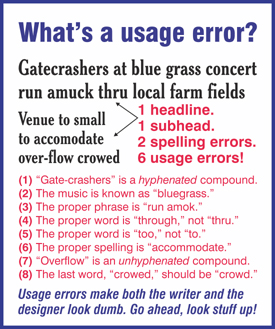
Usage also encompasses elements of grammar like split infinitives (OK sometimes), functional shifts (not OK most of the time), gender neutrality (OK to use the plural pronoun "their" instead of the clumsy "he or she"), contractions, slang, capitalization (know the difference between proper and common nouns), and compound words (some hyphenated, and some not --- look 'em up). Get a copy of Garner's Modern American Usage to go along with your stylebook, and make it a habit to look stuff up. No one is born knowing this stuff. Use Garner's book as a doorstop if you must, but keep it close-at-hand. Another alternative, of course is "The Cranky Editor's Usage Guide to the Most Common 'Trouble Words'" included in The Cranky Editor's Book of Intolerable Fox Paws (Oops! Faux Pas!): Helpful Writing & Style Tips So You Won't Look Stoopid. (Yes, you can BUY the book here.)
Usage errors might slip by the average reader, whose literacy level is descending minute-by-minute, but to an editor, usage errors are an instant indicator that the writer is either inattentive, in over their head, or a dolt. A writer can have everything else under control, but a slip-up in usage can undermine credibility and diminish whatever authority the writer may have brought to a subject. (See the link to the FREE helpful sign in the sidebar at the right.)
(7) Check your spelling. Spell-check is dumb.
Pay attention to spelling. Use your brain in addition to spell-check. Spell-check will never catch the error in the salutation of that letter to your favorite professor when you're asking for his recommendation: "Dead Professor Jones." Oh, dear me! Too late! Because of keyboard adjacencies and the fallibility of the fingers, make sure to double-check words like shot, shut, buck, duck, tuck, botch, and butch. You're welcome.
(8) Make sure you make sense.
Edit for sense. Don't confuse or mislead the reader. Double check your names, dates, titles, and facts. Check for any confusion or ambiguities in your phrasing. Make sure you make sense. For example, in the flow of actual writing, the sportswriter spun out the following sentence without a second thought: "The freshman 380-pound tackle at University of Mass. went to high school in Chicago and was raised largely by his mother." Well, there is nothing really wrong with the sentence, except that it introduces unintended ambiguities that might stall the reader. Perhaps the phrase "raised largely" should have been reworked in the story about the young 380-pounder. Likewise, the "University of Mass." usage provokes an unintended chuckle. Be alert for these kinds of ambiguities and potential embarrassments in your writing.
(9) Pay attention to punctuation.
Pay attention to punctuation. Readers depend upon punctuation for pace and clarity. Inattentive use, misuse, or omission of punctuation can introduce ambiguities, alter meaning, destroy reading flow, and fatigue your readers. For example, missing or misplaced commas can cause a wholesale change in the meaning of a sentence. Need convincing? Consider this straightforward sentence: "The orangutan trainer said the circus ringmaster was a maniac." The problem is that the writer had an entirely different meaning in mind, but didn't bother to put in the punctuation to indicate certain pauses. Here is the sentence with commas properly placed to ensure the writer's intended meaning: "The orangutan trainer, said the circus ringmaster, was a maniac." As you can see, it pays to pay attention to comma placement.
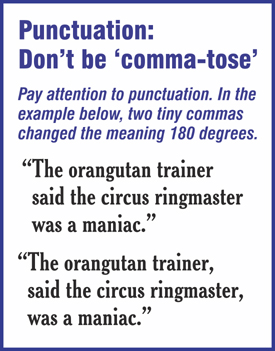
Reading a sentence aloud and being aware of the natural pauses will help you determine where the punctuation goes. You know what you mean when you write out your thoughts in unpunctuated form, but your reader may be lost without the direction provided by proper and consistently applied punctuation. Use your stylebook of choice for guidance on the use of commas, colons, semicolons, quotation marks, apostrophes, hyphens, dashes, and exclamation marks. Or you can consult the chapter in The Cranky Editor's Book of Intolerable Fox Paws (Oops! Faux Pas!): Helpful Writing & Style Tips So You Won't Look Stoopid. (Yes, you can BUY the book here.)
(10) Editing, proofreading, & typographic style.
Editing, proofreading, & typographic style. Editing is best understood by breaking it down into in phases. Large projects for major publishers involve multiple editors, each responsible for a particular stage of a project: concept development; content & organization; grammar & usage; fact-checking; copy editing; and sometimes more. The phalanx of editors work to ensure that a bumbling writer's work is polished to a gleam so that the creator's true genius shines through in the finished product. In the do-it-yourself project, you get to wear all the editorial hats, and do all this stuff yourself. But bear in mind that each editorial phase requires a slightly different focus. The final stage, copy editing, is the category that concerns the application of consistent and proper capitalization, punctuation, spelling, and typographic style.
Typographic style: What is it? Editing for typographic style consistency is within the editorial phase that lies midway between the craft of writing and the craft of type composition. The phrase "typographic style" tends to misdirect, and leads the layman to believe it has something to do with aesthetics, typeface choices, or decorative effects. "Typographic style" is actually much more mundane, but it is essential in the preparation of a professional publication. Applying typographic style to body-text is to apply proper and consistent capitalization, punctuation, abbreviation, and spacing; and proper and consistent use of italics, subscript, superscipt, and small caps --- all guided by standards set forth in a "stylebook." (What's a "stylebook"? See the sidebar at the right.)
The basics of applying consistent typographic style are included in both The Cranky Editor's Book of Intolerable Fox Paws (Oops! Faux Pas!): Helpful Writing & Style Tips So You Won't Look Stoopid, and The Cranky Typographer's Book of Major Annoyances: Helpful Graphics Tips for Do-It-Yourself Designers,. (Yes, you can BUY the book here.) Professional typographic style includes applying conventions like using just one space after a period; using proper "curly" quotation marks and apostrophes instead of inch- and foot-marks; never underlining body text; proper use of italics; proper use of punctuation marks; proper use of abbreviations, initialisms, & acronyms; proper use of state abbreviations in running text instead of two-letter postal abbreviations; proper capitalization; proper spelling of place names and geographic features; and enforcement of any in-house departures from the stylebook of choice. (Unfortunately many of these conventions are lost on the Web, where typographic control remains in its infancy. But conditions will improve.) The goal of typographic style is consistency throughout a publication, so it doesn't look like it was typed by an orangutan. Indeed, consistency in our language, even though it is a relatively newfangled notion, and even though our language is always evolving, is what makes clear communication possible.
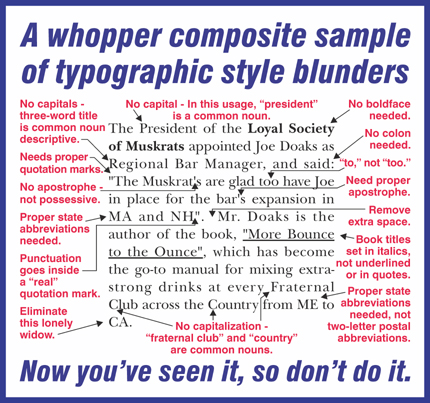
Proofreading: It's different from editing. Ideally editing is for sense, structure, punctuation, spelling, and usage, while proofreading is for catching typos and double-checking typographic stylebook consistency. Edit first; proofread last: It's the last step before text composition for publication. In the printing and publishing industry, standard proofreading symbols in three categories --- for operations, punctuation, and typographic formatting --- are useful for marking up copy for correction. These symbols are included in The Cranky Editor's Book of Intolerable Fox Paws (Oops! Faux Pas!): Helpful Writing & Style Tips So You Won't Look Stoopid.
The above step-by-step breakdown will help those navigating uncharted territory understand the process, stay on track with their own quality control, and achieve a better finished product.
(Bonus Tip #11) Hug your stylebook.
Learn to love your stylebook.That's right, this Bonus Tip is a repeat of Tip #1. Why? Because this tip might be the most helpful in elevating the presentation of your writing. Keep hard copies --- real books --- of your stylebook and dictionary within arm's reach. Use them until they are dog-eared, stained, and limp. Then start again with new copies. (What's a "stylebook"? See the sidebar at the right.)
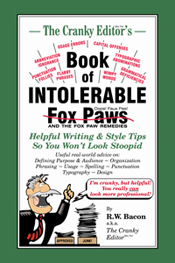
Did you find these
10 FREE Tips helpful?
If you found the above 10 FREE Tips to be helpful, just think if you could have your own entire book of tips by the same author to consult and wear out until it's limp? The Cranky Editor's Book of Intolerable Fox Paws (Oops! Faux Pas!): Helpful Writing & Style Tips So You Won't Look Stoopid, by Reginald W. Bacon, is available for purchase on this website. You can BUY the book here. After soaking up all the information, you'll be able to go forth with your elevated writing skills and help avert the decline of civilization!

